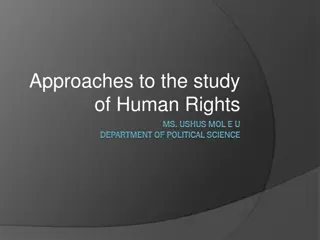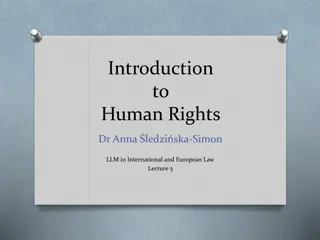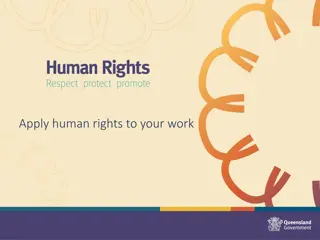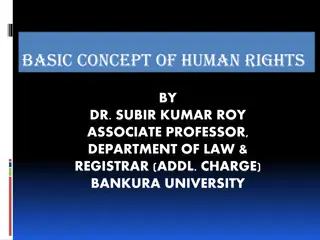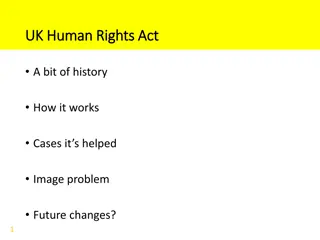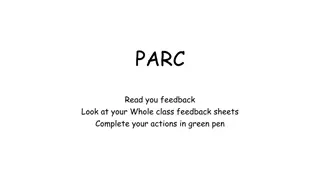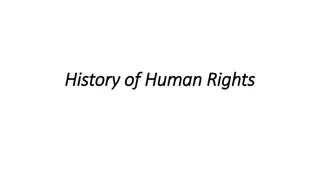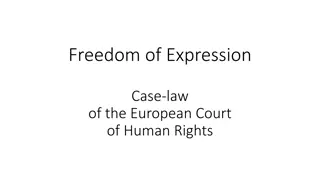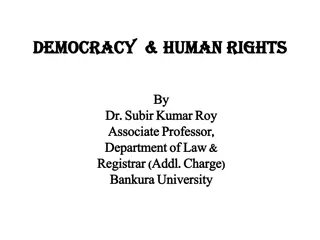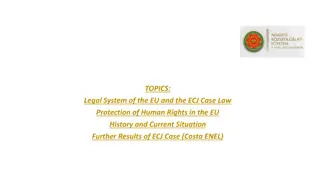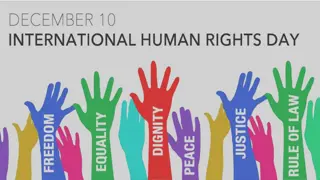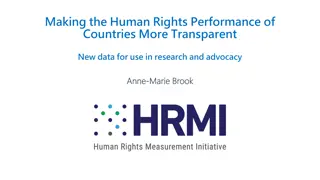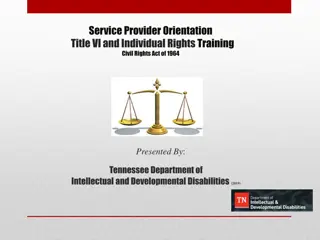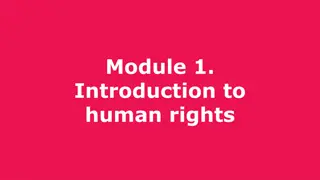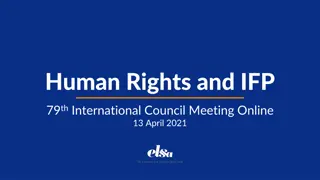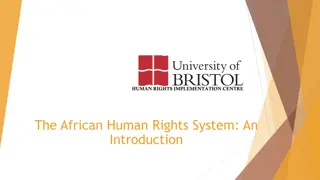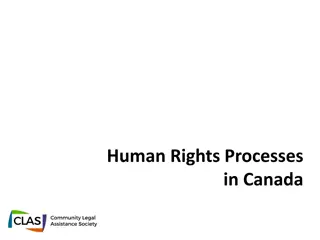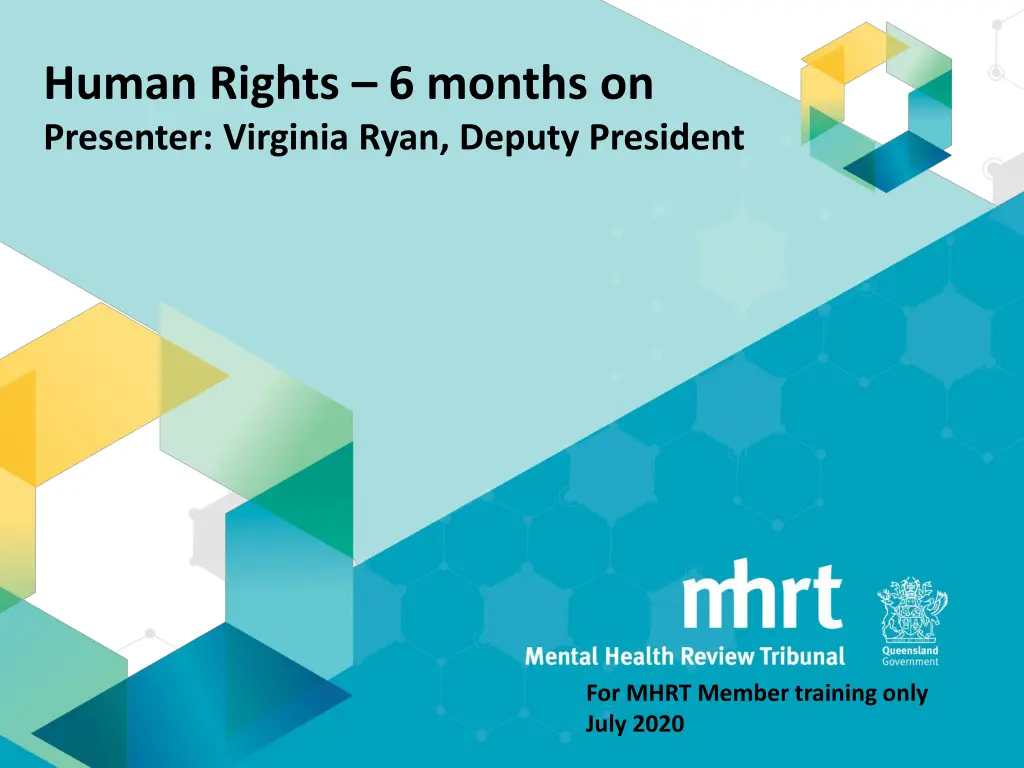
Understanding the Role of Human Rights Act in MHRT Functions
Explore the impact of the Human Rights Act on MHRT members, the 23 distinct human rights outlined, and the importance of promoting a human rights culture within the Queensland public sector. Learn about the MHRT's Human Rights Policy and its relationship to the Mental Health Act.
Download Presentation

Please find below an Image/Link to download the presentation.
The content on the website is provided AS IS for your information and personal use only. It may not be sold, licensed, or shared on other websites without obtaining consent from the author. If you encounter any issues during the download, it is possible that the publisher has removed the file from their server.
You are allowed to download the files provided on this website for personal or commercial use, subject to the condition that they are used lawfully. All files are the property of their respective owners.
The content on the website is provided AS IS for your information and personal use only. It may not be sold, licensed, or shared on other websites without obtaining consent from the author.
E N D
Presentation Transcript
Human Rights 6 months on Presenter: Virginia Ryan, Deputy President For MHRT Member training only July 2020
Introduction Refresher: What does the Human Rights Act require Impact for MHRT Members Complaints or referrals Completing ROPs/MDs Worked example Discussion questions
The Human Rights Act The Human Rights Act 2019 was passed by the Queensland government on 27 February 2019 and commenced on 1 January 2020. The main objectives of the Human Rights Act 2019 are: a) to protect and promote human rights; b) to help build a culture in the Queensland public sector that respects and promotes human rights; and c) to help promote a dialogue about the nature, meaning and scope of human rights. Very similar to Victoria s Charter of Human Rights and Responsibilities.
Impact on MHRT and MHRT Members As a part of the Queensland public sector, the MHRT needs to promote a human rights culture. This will extend to MHRT functions both as a public entity and as a tribunal. Required to act and make decisions in a way compatible with human rights. May refer the following to the Supreme Court: Question of law arising in relation to the application of the Human Rights Act 2019. Question relating to the interpretation of a statutory provision in accordance with the Human Rights Act 2019. Exposed to potential legal proceedings for acts or decisions not compatible with human rights. Exposed to potential complaints to the Queensland Human Rights Commissioner.
What are the human rights? The Human Rights Act contains 23 distinct human rights. You should be familiar with these 23 rights. They are found in sections 15 37 of the Human Rights Act.
The MHRTs Human Rights Policy Copy is available on the MHRT website (public). Policy acknowledges the requirement to consider human rights under both the Human Rights Act and the Mental Health Act. It is expected that at all times while constituting the Tribunal, Members will when interpreting statutory provisions, only do so in a way that is compatible with human rights, to the extent possible that is consistent with the purpose of the provision being interpreted. The policy notes that it should be read as informing and underpinning all other policies and procedures that may touch upon or limit the human rights protected by the Human Rights Act.
Relationship to the Mental Health Act Section 3(2)(a) and (b): The main objects of the Act are to be achieved in a way that safeguards the rights of persons and is the least restrictive of the rights and liberties of a person who has a mental illness. The principles in section 5 must be applied when administering the Act. For example: the right of all persons to the same basic human rights must be recognised and taken into account The person s right to respect for his or her human worth and dignity as an individual must be recognised and taken into account. To the greatest extent practicable, a person is to be encouraged to take part in making decisions affecting the person s life, especially decisions about treatment and care. To the greatest extent practicable, in making a decision about a person, the person s views, wishes and preferences are to be taken into account. A person s age-related, gender-related, religious, communication and other special needs must be recognised and taken into account. There are other principles specific to Aboriginal people and Torres Strait Islanders, persons from culturally and linguistically diverse backgrounds and minors. Section 733(3)(a): In conducting a proceeding, the tribunal must observe the rules of natural justice.
Resources that we provide on our website for Members Links to third party resources including case notes, information sheets and the Victorian Charter Bench Book. MHRT prepared resources: Human Rights Guideline Case Bank Procedure: Referral to the Supreme Court Decision Guides aimed at assisting members to identify relevant rights to consider when making certain types of decisions Information Sheets aimed at looking closer at particular human rights or particular processes under the Human Rights Act Drafting examples human rights considerations in statements of reasons 2 x Masterclasses regarding implementation of the Human Rights Act Masterclass on Aboriginal and Torres Strait Islander Mental Health and Social and Emotional Wellbeing to assist in considering the Aboriginal and Torres Strait Islander cultural right.
Since 1 January 2020 to date We have not received any human rights complaints in accordance with the Human Rights Act. We are not aware of any concerns being raised about the MHRT with the Queensland Human Rights Commissioner. No panel has adjourned a hearing to refer a question to the Supreme Court. We are not aware of any legal proceedings against the MHRT raising an issue in respect of human rights.
Queensland Human Rights Commission Information as at May 2020 #1 Intervention Under the Human Rights Act, the Commission is able to intervene into relevant proceedings. First intervention under that Act on 13 March 2020: Commission intervened in a Supreme Court case considering the coverage of Queensland s electoral donation laws: The Australian Institute for Progress Ltd v The Electoral Commission of Queensland [2020] QSC 54 The Commission argued that in cases where multiple interpretations may be possible consistent with the purpose and text of the legislation, the interpretation most compatible with human rights should be preferred. Content not necessarily relevant to MHRT matters but interesting to note: Commission prepared to intervene. Supreme Court considered the relevant legislative provisions and agreed that an application of the Human Rights Act was required. Supreme Court applied the relevant provisions and identified that the statutory provisions could be interpreted in a way that was compatible with human rights. Source: QHRC website accessed 07/07/2020
Queensland Human Rights Commission Information as at May 2020 #2 Enquiries QHRC received 157 enquiries under the HR Act. 55 complaints lodged. Enquiries regarding: child protection. conditions in prison and poor access to health services in prison. access to health services from the wider population. social housing including eligibility, evictions and maintenance of properties. dealings with police, including treatment in the watch house. Source: QHRC website accessed 07/07/2020
Queensland Human Rights Commission Information as at May 2020 #3 Top 10 human rights most engaged by issues raised by enquirers in the order of prevalence: Recognition and equality before the law (49) Protection of families and children (31) Right to health services (21) Protection from torture, inhumane, cruel and degrading treatment (20) Humane treatment when deprived of liberty (19) Freedom of movement (17) Privacy and reputation (16) Right to liberty and security of the person (15) Cultural rights - Aboriginal peoples and Torres Strait Islander peoples (14) Fair hearing (10) For the majority of enquiries, more than one human right was engaged. Source: QHRC website accessed 07/07/2020
Queensland Human Rights Commission Information as at May 2020 #4 Examples of enquiries made about human rights to the Commission: A relative of a teenager in residential care raised concerns that he is not getting enough family contact and has limited access to internet to complete his schooling. A homeless man was sleeping rough. He says he was awoken at midnight and given a move on direction by a council worker. A prisoner is concerned about being transferred to another prison far away from his family so he won t be able to have visits anymore. A woman with a disability gave birth to a baby who was removed from her care, and although she wants to breastfeed she is not being supported to do so. Source: QHRC website accessed 07/07/2020
Completing ROPs and MDs The difference between the 2 documents: ROP: to record all relevant evidence that is raised at hearings to comply with the Recording of Evidence Act. It must also record key information including attendees and decisions made by the panel. MD: to record the confidential deliberations of the members. It must record the reason that the panel reached the decision that it did. For human rights purposes: ROP: record any issues raised in the hearing relevant to human rights, record any submissions raised by representatives about human rights. MD: record the panel s deliberations what rights are potentially engaged, are they limited, if so is that limitation reasonable.
Tips for completing ROPs and MDs Keep your pocket guide handy and only record the section numbers rather than the full section names for each right. Remember the questions posed in the pocket guide to assist you in identifying whether the limit is reasonable and justified. Using these questions as headings may assist in organising your discussion/thinking. You may wish to identify the rights separately and then prepare a summary that combines the rationale for why the decision is compatible with the Human Rights Act may be less repetitive.
Completing MD with a table You may wish to utilise a matrix format for speed of recording. The example below lists each of the questions from the pocket guide along the top and has a new row for each human right considered. This allows members to make notes and add reasons quickly as they discuss. Impact? Lawful? Purpose? Rational? Necessary? Fair & Balanced? s17( c) Pt receiving treatment Y - MHA To assist pt to become well Pt currently unwell and poses risk to self Y Pt will not accept treatment voluntarily. No less restrictive method available. Y pt requires treatment to remain well. No other way to receive. Pt entitled to receive treatment. s19 Considered by no impact - - - - - s25 Other people have access to personal information Y - MHA To achieve a fair hearing Y only limited people receive sufficient security of information Y information needed to conduct hearing and make decision Y fair decision could not be made without the information
Worked example Scenario Ms A is a 40 year old Aboriginal woman. was placed on an FO after being found of unsound mind in relation to 2 charges of murder. Victims were her sister and niece (a minor). Diagnosis of schizophrenia untreated at the time of the offence. Currently an inpatient accessing LCT: unescorted leave on-grounds and escorted leave off- grounds. Current mental state: Stable. No psychotic symptoms currently. Judgement is fair and insight is developing. Ms A does not disagree that she has a mental illness or that she needs medication. Current circumstances: Treated with depot medication. Risk to self and others reported to be low. But this may change if non-compliant with medication. Risk of non-compliance is assessed as moderate. Has had some contact with family by telephone but some family members do not want anything to do with Ms A any longer. Some evidence that members of her home community in Far North Queensland did not want her to move back there. Ms A wants to access more off-ground leave. She feels disconnected from her old life and old community in Far North Queensland.
Worked example Identification of relevant human rights Consider: involuntary medical treatment (limiting the right in s17(c)) restrictions on freedom of movement (s19) cultural rights generally and those of Aboriginal and Torres Strait Islander peoples (s27, s28) obligation on the Tribunal to provide a fair hearing (s31) equal treatment before the law (s15). Any others?
Worked example Are the limits reasonable? Human Right Justification/Consideration Involuntary medical treatment (limiting the right in s17(c)) Ms A requires medical treatment for her diagnosed mental illness. Presents a risk of non-compliance and relapse. Risk to community safety and risk of violence to others. Freedom of movement (s19) Ms A s progress and stability arise, in part, from controlled inpatient environment. Unrestricted freedom of movement likely to give rise to increased risk. Cultural rights (s27, s28) Dealt with on next slide Fair hearing (s31) Panel was extended panel of 4 people, relevant material provided to Ms A and her legal rep, represented by independent lawyer, evidence taken in her presence, afforded opportunity to contribute. Equal treatment (s15) Considered in the context of lawful restrictions imposed by the MHC in making the FO and the MHA2016.
Worked example Cultural rights Some things to consider: Does Ms A have access to support from an Indigenous Mental Health Worker? How is contact with Ms A s family and supports from her community facilitated and can more be done to allow appropriate contact via telephone or video conferencing? Have discussions been held with Ms A about what activities could be undertaken in her current location (Brisbane) to assist with her connection to culture? If there are activities or locations in the area that may assist Ms A with her connection to culture, without increasing risk, how can the Tribunal write conditions to allow such access? What else?
Worked example Conclusion Identified rights may be engaged and limited, however, those limitations are justified for the reasons outlined above. Therefore, decision is consistent with the Human Rights Act.
Discussion #1 Have you found that a lot of the considerations you are making specific to human rights, are things that you would have already considered under the Mental Health Act anyway maybe just phrased differently? OR Are you finding that the Human Rights Act has added new considerations to your decision-making?
Discussion #2 Are there particular rights you find more challenging to consider? If so, which ones? Are there particular matters which are more challenging with respect to human rights? For example, ECT?
Discussion #3 How might you change a condition so that it is more compatible with human rights? Are there some common ones you find yourself changing or deleting?
Discussion #4 Do you have the training and resources you need to be able to make your decisions in accordance with the Human Rights Act? If not, what else can we provide?

